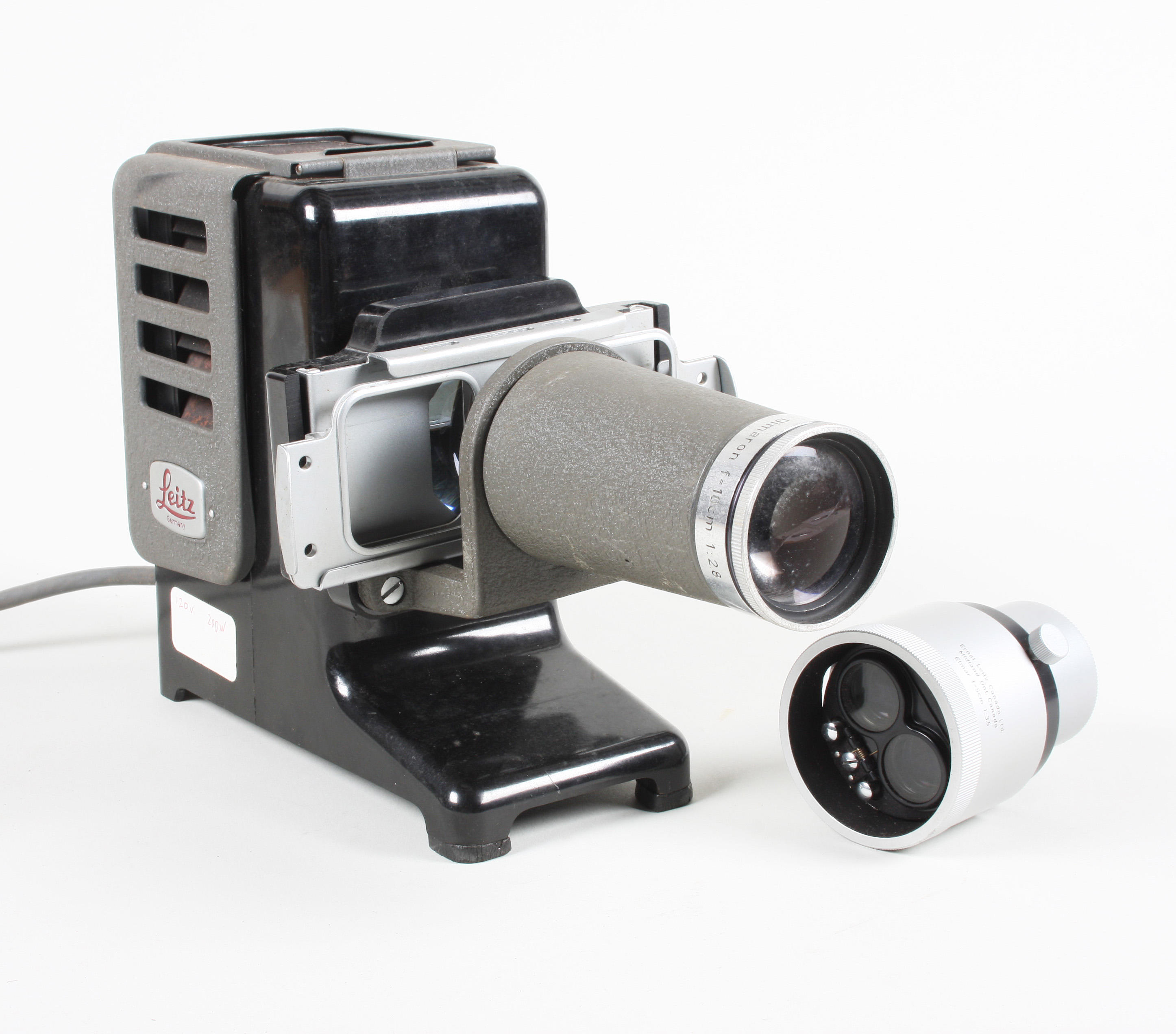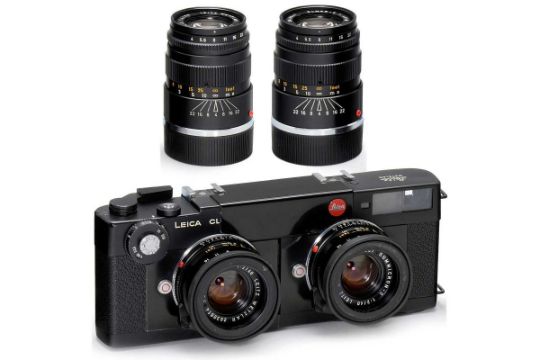Here a most unusual prototype Stereo Elmar lens is being offered which lacks such a receptacle for the finder. This does not represent a later modification, but its original status. Presumably the lens was intended for experimental use in combination with a different finder solution. LITERATURE Wilhelm Albert, Die Geburtstage der Leitz Fotokonstruktionen seit 1927, Wetzlar 1990, p. 49-56; James L. Lager (ed.), Leica Illustrated History, Vol. III, 1998, p. 277-278; Paul-Henry-van Hasbroeck (ed.), Leica, a history illustrating every model and accessory 2nd. ed., colour plate XXIV. From 1937 – 1942, Wilhelm Albert designed paired lenses, held in a common focusing mount for stereo-photography. These lenses produced a pair of 18 x 24 mm images within the full 24 x 36 mm frame. A single ring controlled the diaphragm of both lenses. Two versions of such lenses were made during WWII, both of 3.5 cm focal length and with the typical black finished front plate: the f/2.5 Stemar and the f/3.5 Stereo Elmar. In the 1950s, this design was further developed and turned into the familiar 3.3 cm Stemar lens system. The wartime stereo lenses are exceedingly rare, as less than 50 units were produced. Usually, the lens mount was equipped with a receptacle for holding the arm pin of a specially modified VIDOM viewfinder. In der Zeit zwischen 1937 und 1942 entwarf Wilhelm Albert Doppelobjektive in einem gemeinsamen Schneckengang für die Stereofotografie. Diese Objektive erzeugten ein Aufnahmepaar von zwei mal 18 x 24 mm innerhalb des vollen 24 x 36 mm Formats. Mittels eines Einstellrings konnten die Blenden beider Objektive gleichzeitig gesteuert werden. Während des zweiten Weltkrieges wurden zwei Versionen solcher Stereo-Objektive mit der typischen schwarz lackierten Frontplatte und einer Brennweite von 3,5 cm produziert: das Stemar 1:2,5 und das Stereo Elmar 1:3,5. In den 1950er Jahren wurde diese Konstruktion wieder aufgegriffen und es entstand das bekannte 3,3 cm Stemar. Die Stereo-Objektive aus der Kriegszeit sind extrem selten, es wurden insgesamt weniger als 50 Exemplare produziert. Normalerweise war die Objektivfassung mit einer Aufnahme ausgestattet, in die der Pin am Arm eines speziell modifizierten VIDOM Suchers eingehängt werden konnte.
Here a most unusual prototype Stereo Elmar lens is being offered which lacks such a receptacle for the finder. This does not represent a later modification, but its original status. Presumably the lens was intended for experimental use in combination with a different finder solution. LITERATURE Wilhelm Albert, Die Geburtstage der Leitz Fotokonstruktionen seit 1927, Wetzlar 1990, p. 49-56; James L. Lager (ed.), Leica Illustrated History, Vol. III, 1998, p. 277-278; Paul-Henry-van Hasbroeck (ed.), Leica, a history illustrating every model and accessory 2nd. ed., colour plate XXIV. From 1937 – 1942, Wilhelm Albert designed paired lenses, held in a common focusing mount for stereo-photography. These lenses produced a pair of 18 x 24 mm images within the full 24 x 36 mm frame. A single ring controlled the diaphragm of both lenses. Two versions of such lenses were made during WWII, both of 3.5 cm focal length and with the typical black finished front plate: the f/2.5 Stemar and the f/3.5 Stereo Elmar. In the 1950s, this design was further developed and turned into the familiar 3.3 cm Stemar lens system. The wartime stereo lenses are exceedingly rare, as less than 50 units were produced. Usually, the lens mount was equipped with a receptacle for holding the arm pin of a specially modified VIDOM viewfinder. In der Zeit zwischen 1937 und 1942 entwarf Wilhelm Albert Doppelobjektive in einem gemeinsamen Schneckengang für die Stereofotografie. Diese Objektive erzeugten ein Aufnahmepaar von zwei mal 18 x 24 mm innerhalb des vollen 24 x 36 mm Formats. Mittels eines Einstellrings konnten die Blenden beider Objektive gleichzeitig gesteuert werden. Während des zweiten Weltkrieges wurden zwei Versionen solcher Stereo-Objektive mit der typischen schwarz lackierten Frontplatte und einer Brennweite von 3,5 cm produziert: das Stemar 1:2,5 und das Stereo Elmar 1:3,5. In den 1950er Jahren wurde diese Konstruktion wieder aufgegriffen und es entstand das bekannte 3,3 cm Stemar. Die Stereo-Objektive aus der Kriegszeit sind extrem selten, es wurden insgesamt weniger als 50 Exemplare produziert. Normalerweise war die Objektivfassung mit einer Aufnahme ausgestattet, in die der Pin am Arm eines speziell modifizierten VIDOM Suchers eingehängt werden konnte.















Try LotSearch and its premium features for 7 days - without any costs!
Be notified automatically about new items in upcoming auctions.
Create an alert